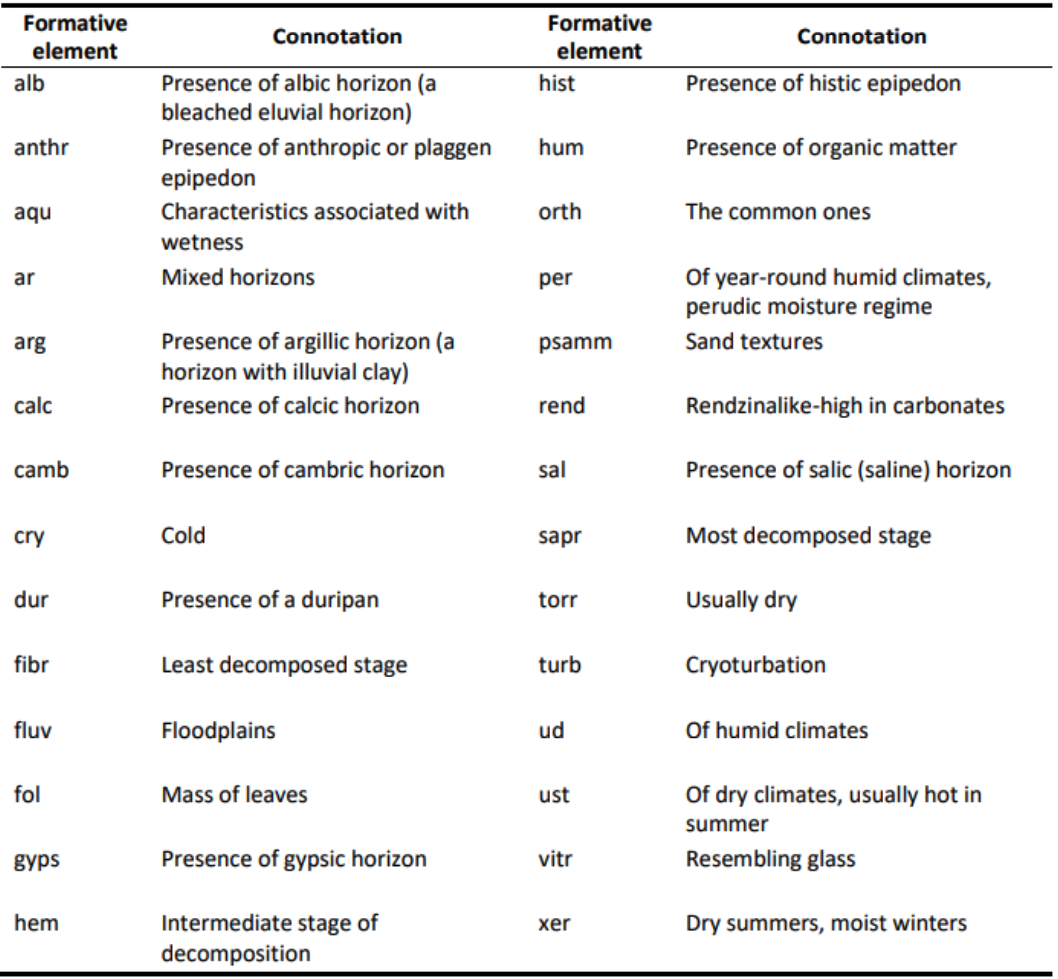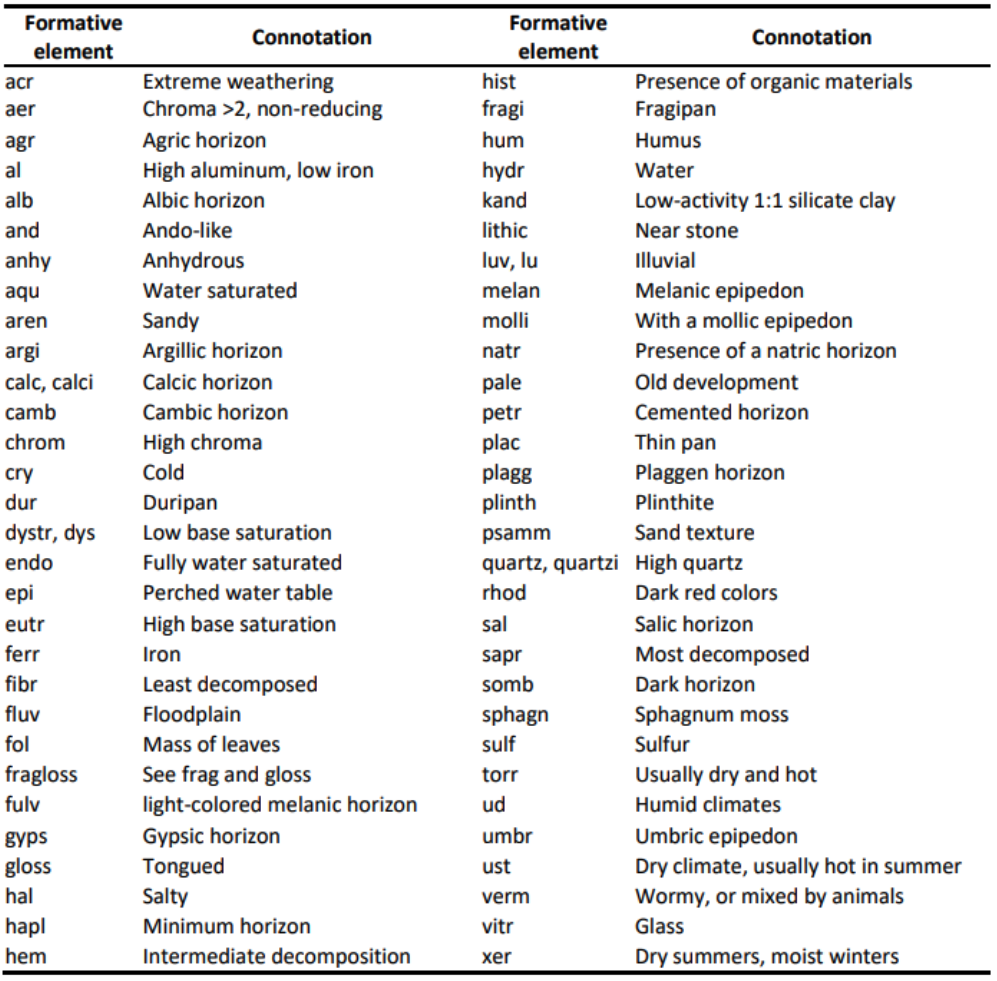3.1: Introduction to Soil Taxonomy
- Page ID
- 14441
The word, “taxonomy” is based on the Greek words “taxis”, meaning arrangement; and “nomia”, meaning method. In biology, taxonomy refers to a hierarchical system in which organisms are grouped based on shared characteristics, with domains and kingdoms at the top of the hierarchy, and genus and species at the lowest levels. Similarly, Soil Taxonomy is a hierarchical system used to group soils based on observable or measurable characteristics. A common application of soil classification (the act of identifying the taxonomic classification for a given soil) is to develop models of how soils of different classifications associate with one another within a landscape, which can eventually be used in soil mapping. The primary concepts of soil classification using Soil Taxonomy will be reviewed in this lab, followed by an overview of the Web Soil Survey (United States Department of Agriculture Natural Resources Conservation Service, 2016).
| Morphological property | Description | Morphological property | Description |
|---|---|---|---|
| Horizon designation | Ap | Structure grade | Moderate |
| Upper depth | 0 in | Structure size | Medium |
| Lower depth | 9 in | Structure type (shape) | Granular |
| Color name | Dark grayish brown | Moist consistence | very friable |
| Munsell hue | 10YR | Roots | Many fine roots |
| Munsell value | 4 | pH | Slightly acid |
| Munsell chroma | 2 | Boundary | clear smooth |
| Textural class | Silt loam |
Completing a soil profile description involves a systematic approach:
- Observing the landscape setting.
- Examining the morphological features like texture, structure, color, consistence, etc. of the soil to distinguish any layers or horizons.
- Describing in detail the texture, structure, color, consistence, and other features of each horizon.
- Assigning horizon designations to each layer.
- Classifying the soil on the basis of its morphology and horizonation.
THE TAXONOMICAL SYSTEM OF SOIL
A comprehensive classification system is important for any science: soil science, plant science, biology, geology, among many others. Effective taxonomy allows us to organize knowledge and learn new relationships. Soil Taxonomy helps in extrapolating soil management research among similar soils around the world. Soil Taxonomy is a quantitative system based on soil properties that can be observed or measured, organized in a hierarchy based on six categories beginning with 12 broad soil orders and narrowing in specificity to more than 23,000 series. The organization of a taxonomic name by category is illustrated in Figure 1.

IDENTIFICATION OF THE TAXONOMIC CLASS OF A SOIL
Classification of soils is determined using the systematic approach outlined in the Keys to Soil Taxonomy. Individuals must begin with the “Key to Soil Orders” and eliminate, one by one, the classes including criteria which do not meet the soil in question. Whichever order’s criteria aligns best with the soil in question first will be the soil order selected. This process is used for all subsequent categories in the ordering of order, suborder, great group, and subgroup. Family and Series are determined by other individual methods using criteria outlined in the Keys to Soil Taxonomy (2014).
Order
There are 12 soil orders in total (Table 4). The geographical range of each order is dependent upon several environmental processes and climatic factors (i.e. temperature, precipitation, etc.) leading to soil formation. Soil order is the first to be determined when classifying a soil.
Table 4. “Simplified key to the 12 soil orders” by Colby J. Moorberg and David A. Crouse is licensed under CC by 4.0 The bolded syllable in each order is the formative element used in the names of suborders and lower taxonomic levels.

Suborder
Soil suborders are determined based on soil moisture regimes and diagnostic features. Formative elements specify unique soil properties at each taxonomic level and has a connotation for a given soil.
The formative elements for suborder are listed in, (Table 5).
Table 5. “Formative elements used to identify various suborders in Soil Taxonomy” by Colby J. Moorberg and David A. Crouse is licensed under CC by 4.0

Great group
The great group expresses the degree of diagnostic horizon expression within each suborder taxa. The formative elements for great group are listed in (Table 6).
Table 6. “Formative elements for names of great groups and their connotations” by Colby J. Moorberg and David A. Crouse is licensed under CC by 4.0

Subgroup
A soil’s subgroup is defined by properties that are transitional or similar to those found in other orders, suborders, and great groups.
Family
The family is typically comprised of more than one component that is determined for the soil in question using information detailed in chapter 17 of the Keys to Soil taxonomy. The technical family name is comprised of descriptive terms for family information such as, particle size class and mineralogy of control section, soil temperature regime, CEC, depth, rupture-resistance, etc.
Complete taxonomical name
After each category is subsequently determined by the systematical methods of the Keys to Soil Taxonomy, a complete taxonomic name is the end result (Figure2). A complete taxonomic name communicates a great deal of information about the soil if we understand each part of the name (Table 8).

Table 8. “Translation of the taxonomic classification of the Harney Series” by Colby J. Moorberg and David A. Crouse is licensed under CC by 4.0



